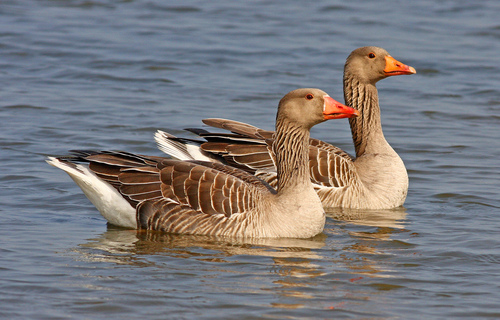
Greylag Goose
The Greylag Goose (Anser anser) is a large, bulky goose species found across Eurasia. It is the largest and bulkiest of the wild geese native to Europe and Asia and is the ancestor of most domestic goose breeds. Greylags play a significant role in wetland ecosystems, grazing on vegetation and contributing to nutrient cycling. They have also held cultural significance, appearing in folklore and literature, and, of course, through their domesticated descendants, have been important to human agriculture for centuries.
74-91 cm
Length
147-180 cm
Wingspan
Least Concern
Conservation Status
Distribution
The Greylag Goose has a wide distribution. Breeding populations are found across Europe and Asia, from Iceland and the UK in the west to eastern Siberia and China. Northern populations are migratory, wintering in southern Europe, North Africa, the Middle East, and parts of Asia, including India and Southeast Asia. They have a broad altitudinal range, inhabiting areas from sea level to mountainous regions.
Lifespan
The average lifespan in the wild is around 8-10 years, but they can live much longer, with records exceeding 20 years.
Greylag Goose's Habitat
Habitat Types
Wetlands, Marshes, Lakes, Rivers, Estuaries, Agricultural fields (particularly during migration and winter)
Climate Zones
Temperate, Boreal, Subarctic (breeding), Mediterranean (wintering)
Adaptations
Greylag Geese are well-adapted to aquatic environments. They have webbed feet for efficient swimming and a bill designed for grazing on vegetation. Their dense, waterproof plumage provides insulation in cold climates.
Variations
Two main subspecies are generally recognized: *Anser anser anser* (western greylag goose) and *Anser anser rubrirostris* (eastern greylag goose). The eastern subspecies tends to be slightly larger and has a pinkish bill, while the western subspecies has an orange bill.
Appearance
Breeding Plumage
Plumage is generally similar year-round.
Seasonal Feather Changes
There is minimal seasonal variation in plumage.
Sex Based Plumage Differences
There is little to no sexual dimorphism in plumage. Both sexes have greyish-brown body plumage with a lighter, barred belly and a white undertail.
Notable Features
Bulky body shape, Orange or pink bill (depending on subspecies), Pink legs and feet, White-tipped tail feathers
Diet and Feeding
Primary Foods
Grasses, Sedges, Roots, Stems, Leaves, Seeds, Grains (especially in agricultural areas)
Foraging Behavior
Greylag Geese are primarily grazers, feeding on vegetation in wetlands, grasslands, and agricultural fields. They often graze in flocks, and they can also feed by dabbling in shallow water.
Specializations
Their bill is well-suited for grazing, with serrated edges that help them efficiently crop vegetation.
Seasonal Diet Variations
Their diet varies seasonally depending on food availability. During the breeding season, they may consume more protein-rich foods like insects and small invertebrates. In winter, they may rely more on grains and agricultural crops.
Behavior
Social Structure
Greylag Geese are highly social, especially outside the breeding season. They form large flocks during migration and wintering, often numbering in the thousands. During the breeding season, they are more territorial.
Communication
Loud honking calls, Head and neck displays, Wing-flapping
Migration
Northern populations are migratory, undertaking long-distance flights between breeding and wintering grounds. They often fly in V-formations, which helps to conserve energy. Migration is triggered by changes in day length and temperature.
Territorial or Group Behaviors
During the breeding season, pairs defend territories around their nests. Outside the breeding season, they are highly gregarious and form large flocks.
Conservation
Threats
Habitat loss and degradation (due to drainage of wetlands and agricultural intensification), Hunting (in some areas), Climate change (potentially affecting breeding success and migration patterns), Disturbance from human activities
Protection Programs
International agreements such as the African-Eurasian Waterbird Agreement (AEWA), National wildlife refuge programs, Habitat restoration projects
Local National Laws
Protected under various national and international laws, including the EU Birds Directive.
Population Trend
Increasing
Population Estimates
The global population is estimated to be around 920,000 - 1,100,000 individuals.
Interesting Facts
Greylag Geese are the ancestors of most domestic goose breeds.
Domestication likely began thousands of years ago in various parts of Europe and Asia.
They can fly at altitudes of up to 29,000 feet.
This has been documented during migration over the Himalayas.
Greylag Geese were used in early studies of animal behavior.
Konrad Lorenz, a Nobel Prize-winning ethologist, famously studied imprinting in Greylag Geese.
Faqs about Greylag Goose
What is the difference between a Greylag Goose and a Canada Goose?
Greylag Geese are generally smaller and have orange or pink bills and pink legs, while Canada Geese have black bills, black legs, and a distinctive black head and neck with a white chinstrap.
Are Greylag Geese aggressive?
They can be aggressive, especially during the breeding season when defending their nests and young. It's best to observe them from a distance.
What do Greylag Geese eat?
They are primarily herbivores, grazing on grasses, sedges, roots, and other vegetation. They also consume grains and agricultural crops, especially during migration and winter.
Do Greylag Geese mate for life?
Greylag geese are known for their strong pair bonds, and many do mate for life. However, if one partner dies, the surviving goose may find a new mate.
Copyright @ Nature Style Limited. All Rights Reserved.
 English
English